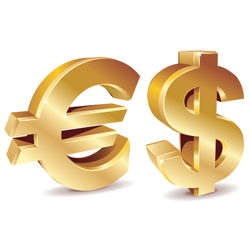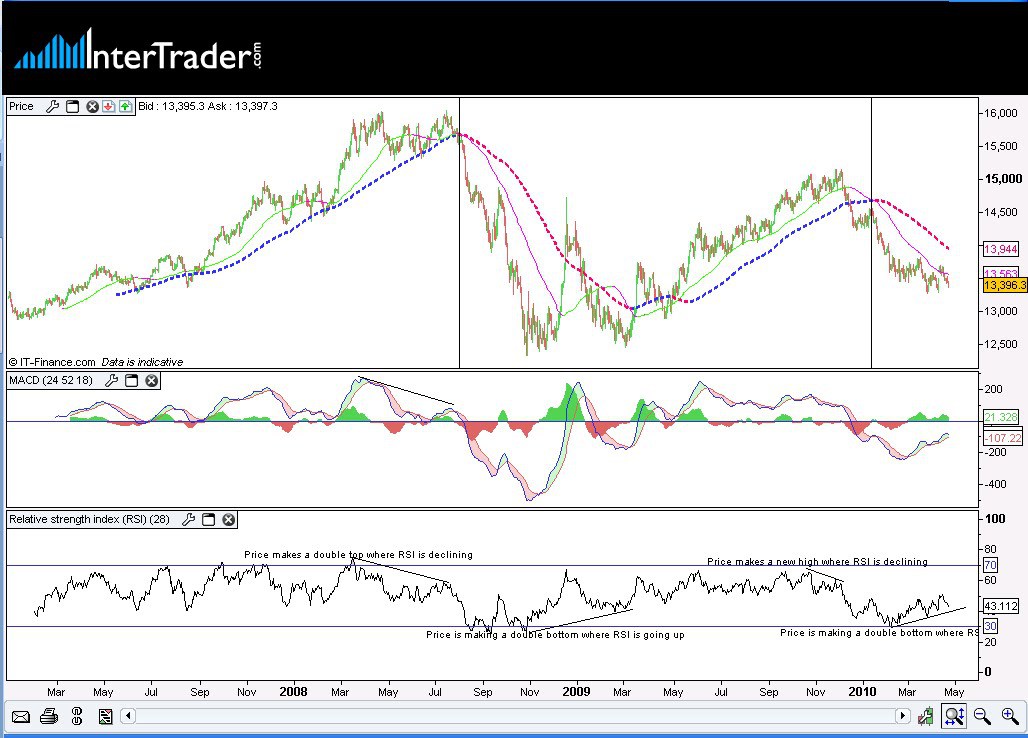EUR/USD Technical Analysis Case Study

The methodology is to look into past performance and find leading indicators that can provide us with clues for the future. For that we will be using a set of overlays and indicators.
I divide the different tools in into two types. The first are primary tools, the signals they provide are used to take a view on the market. The second type are confirmation tools.
Before opening a position most of my indicators should tell the same story. In this analysis I will be using the following
Primary:
- EMA (120) and EMA (60) [Exponential moving average on price]
- MACD (24,52,18) [Moving Average Convergence Divergence)
Confirmation:
- RSI (28) [Relative strength index]
- Fibonacci retracements

Past performance:
In August of 2008 we can see observe the following phenomenon. Price is making a new high where:- The EMA(60) exhibits a bearish engulfing over the EMA(120)
- MACD plummets from 272 to around 68
- RSI declines from 73 to 54
In late October 2009 and at the beginning of November of the same year, after the EUR depreciated by 23%, we can observe the following:
- MACD is in positive divergence from it’s signal line
- RSI is going up
- EMA (60) is well below EMA(120)
In reality, the price recovered by 16% in less than two months. The reversal is not sustained and a classic head and shoulders formation, with a double bottom, is formed between October 2008 and March 2009.
Only in May of 2009 we can again see a clear combination of signals suggesting a sustainable trend reversal.
- EMA(60) has crossed over EMA(120)
- MACD is in positive divergence against it’s signal line and in an overall bullish trend.
- RSI climbs to 47
- Price crosses the 61.80% Fibonacci retracement mark.
When trading, one should always have a stop loss and a target. I tend to use a concrete price for stop loss and indicators for my take profit.
The stop loss should be placed at the bottom of the movement dated April 19th, price $1.2980. Conversely, I would set my profit target as when the EMA(60) crosses under EMA(120).
This method would have produced a profit of 850 pips over an 8 months period.
At the beginning of January we can see the exact mirror pattern of the May 2009 one, suggesting it’s time to short the EUR.
Current Performance:
Now that we’ve concluded the analysis, it’s time to evaluate where we now:- EMA(60) is in a 397 pips (2.37%) negative divergence from the EMA (120)
- MACD is climbing steadily and is in positive divergence from it’s signal line
- RSI is in an upwards channel
- Price touched the 61.8% Fibonacci retracement line.
Action: I am currently short of this pair and, therefore, I would hold for now. If I was neutral I would wait for the pair to test $1.3400 support. If the support holds, and there are signs of a bullish engulfing from the EMA (60), then I would take a cautious long position.
From a fundamental perspective my view on the Euro remains bearish. The latest crisis had a dividing affect on the Eurozone.
We have strong economies, i.e Germany and France, that are on the road to recovery where inflation lurks around the corner. On the other side of things, the PIGS, that is Portugal, Ireland, Spain and Greece, are in significant debt and I can’t see any light at the end of this tunnel.
The divergence may have devastating affects on the Euro as they require different fiscal policies with a deadlocked monetary policy. In particular, the ECB cannot increase interest rates as it will push the PIGS into defaulting on their debts.
Spread betting and CFD trading carry a high level of risk to your capital and you may lose more than your initial investment. Spread betting and CFD trading may not be suitable for all investors. Only speculate with money that you can afford to lose. Please ensure you fully understand the risks involved and seek independent financial advice where necessary.
